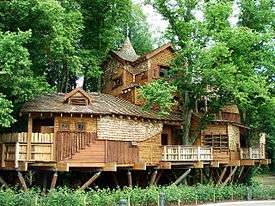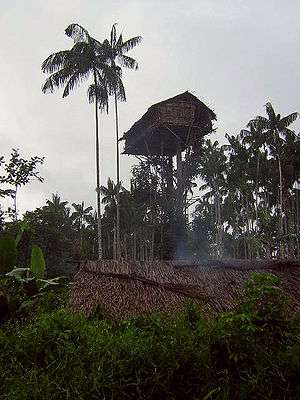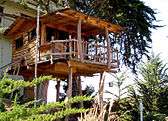Tree house

A tree house, tree fort or treeshed is a platform or building constructed around, next to or among the trunk or branches of one or more mature trees while above ground level. Tree houses can be used for recreation, work space, habitation, observation or as temporary retreats.
Use
Building tree platforms or nests as a shelter from dangers on the ground is a habit of all the great apes, and may have been inherited by humans. It is true that evidence of prehistoric man-made tree houses have never been found by paleoanthropologists, but remains of wooden tree houses would not remain. However, evidence for cave accommodation, terrestrial man-made rock shelters, and bonfires should be possible to find if they had existed, but are scarce from earlier than 40000 years ago. This has led to a hypothesis that archaic humans may have lived in trees until about 40000 years ago.[1]
Even today, treehouses are built by some indigenous people in order to escape the danger and adversity on the ground. In some parts of the tropics, houses are either fastened to trees or elevated on stilts to keep the living quarters above the ground to protect occupants and stored food from scavenging animals. The Korowai, a Papuan tribe in the southeast of Irian Jaya, live in tree houses, some nearly 40 metres (130 ft) high, as protection against a tribe of neighbouring head-hunters, the Citak.[2]
Modern tree houses are usually built as a hut for children or for leisure purposes. Modern tree houses may also be integrated into existing hotel facilities. In Europe treehouses are usually built as Childrens Facilities and recently also as offices.
Along with subterranean and ground level houses, tree houses are an option for building eco-friendly houses in remote forest areas, because they do not require a clearing of a certain area of forest. The wildlife, climate and illumination on ground level in areas of dense close-canopy forest is not desirable to some people.
Support methods and new technology

There are numerous techniques to fasten the structure to the tree which seek to minimize tree damage.[3]
The construction of modern tree houses usually starts with the creation of a rigid platform, on which the house will be placed; the platform will lean (possibly on the corners) on the branches.[4] In case there aren’t enough suitable supports, the methods to support the platform are:
- Struts and stilts
Struts and stilts are used for relieving weights on a lower elevation or straight to the ground; Tree houses supported by stilts weigh much less on the tree and help to prevent stress, potential strain, and injury caused by puncture holes.[5] Stilts are typically anchored into the ground with concrete although new designs, such as the “Diamond Pier”, accelerates installation time and they are less invasive for the root system.[6] Stilts are considered the easiest method of supporting larger tree houses, and can also increase structural support and safety.
- Stay rods
Stay rods are used for relieving weights on a higher elevation. These systems are particularly useful to control movements caused by wind or tree growth, however they are the used less often, due to the natural limits of the systems. Higher elevation and more branches tailing off decreases capacity and increases wind sensibility.[7] As building materials for hanging are used ropes, wire cables, tension fasteners, springs etc.
- Friction and tension fasteners
Friction and tension fasteners are the most common noninvasive methods of securing tree houses. They do not use nails, screws or bolts, but instead grip the beams to the trunk by means of counter-beam, threaded bars, or tying.
- Invasive methods
Invasive methods are all methods that use nails, screws, bolts, kingpins, etc. Because these methods require punctures in the tree, they must be planned properly in order to minimize stress.[8] Not all species of plants suffer from puncture in the same way, depending partly on whether the sap conduits run in the pith or in the bark. Nails are generally not recommended.[9] A new development called the treehouse attachment bolt (TAB) can support greater weights than earlier methods.
Popularity

Since the mid-1990s, recreational tree houses have enjoyed a rise in popularity in countries such as the United States and parts of Europe.[10] This has been due to increased disposable income, better technology for builders, research into safe building practices and an increased interest in environmental issues, particularly sustainable living. This growing popularity is also reflected in a rise of social media channels and websites specially dedicated to featuring remarkable tree houses around the world.[11]
Increased popularity has, in turn, given rise to demand for businesses covering all building and design work for clients. There are over 30 businesses in Europe and the USA[12] specializing in the construction of tree houses of various degrees of permanence and sophistication, from children's play structures to fully functioning homes.
Popularity of tree house hotels is equally growing, with a number of booking websites offering accommodation in tree houses.[13]
Building regulations
Many areas of the world have no specific planning laws for tree houses, so the legal issues can be confusing to both the builder and the local planning departments. Treehouses can be exempt, partially regulated or fully regulated - depending on the locale.
In some cases, tree houses are exempted from standard building regulations, as they're considered outside of the regulations specification. An exemption may be given to a builder if the tree house is in a remote or non-urban location. Alternatively, a tree house may be included in the same category as structures such as garden sheds, sometimes called a "temporary structure". There may be restrictions on height, distance from boundary and privacy for nearby properties. There are various grey areas in these laws, as they were not specifically designed for tree-borne structures. A very small number of planning departments have specific regulations for tree houses, which set out clearly what may be built and where. For precaution of safety during the tree house construction, it is usually best to do as much work as possible on the ground and also concerned be about its long-term viability.
Protest communities
The tree house has been central to various environmental protest communities around the world, in a technique, popularized, known as tree sitting. This method may be used in protests against proposed road building or old growth forestry operations. Tree houses are used as a method of defence from which it is difficult and costly to safely evict the protesters and begin work. Julia Butterfly Hill is a particularly well known tree sitter who occupied a Californian Redwood for 738 days, saving the tree and others in the immediate area. Her accommodation consisted of two 3m2 (29 sq ft) platforms 60 m (200 ft) above the ground.[14]
Image gallery
- Tree houses

 Korowai Treehouse
Korowai Treehouse Tree house built for children
Tree house built for children Tree house built with recycled materials, Néthen, Belgium
Tree house built with recycled materials, Néthen, Belgium- Noninvasive method of fixing a tree platform

See also
- Chêne chapelle
- Fab Tree Hab – a house made of living trees at MIT
- Out'n'About – a tree house oriented bed and breakfast in Cave Junction, Oregon
- Stilt house
- Tree climbing
References

- ↑ Donald R Perry, Interpreting evidence: Tree houses, 21st Century Anthropology: A Reference Handbook, SAGE Publications, 2010, page 365-366
- ↑ Head-Hunters Drove Papuan Tribe Into Tree-Houses
- ↑ "Architecture Thesis, bachelor degree".
- ↑ "Garden Tree House Design". Cheeky Monkey Tree Houses. Retrieved 22 March 2013.
- ↑ "Tree injury". Retrieved 2011-05-12.
- ↑ "Diamond Pier". Retrieved 2011-05-12.
- ↑ Bahamon, Alejandro (2007). Treehouses Living a Dream. New York, NY: Collins Design. p. 8. ISBN 0-06-078001-0.
- ↑ "friction fastening advice". Retrieved 2011-05-12.
- ↑ "Danger of nails". Retrieved 2011-05-12.
- ↑ Henderson, Paula; Adam Mornement (2005). Treehouses. London, UK: Frances Lincoln Ltd. p. 7. ISBN 0-7112-2437-4.
- ↑ "Treehouses around the world on a map". Treehouse Map. Retrieved 2016-06-17.
- ↑ "Commercial treehouse builder list". Retrieved 2007-11-20.
- ↑ "Best treehouse hotels on booking.com in 2016 - Treehouse Map". Treehouse Map. 2016-06-16. Retrieved 2016-06-17.
- ↑ Henderson, Paula; Adam Mornement (2005). Treehouses. London, UK: Frances Lincoln Ltd. p. 65. ISBN 0-7112-2437-4.
- ↑ "List of Treehouses in Kerala, India".
External links
 Media related to Buildings in trees at Wikimedia Commons
Media related to Buildings in trees at Wikimedia Commons- Short documentary
- Map of tree houses & treehouse hotels from around the world